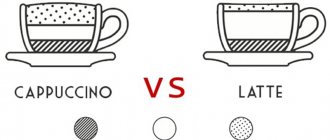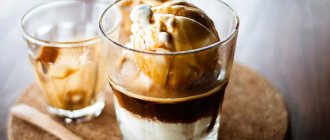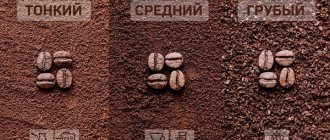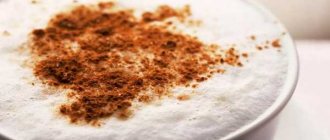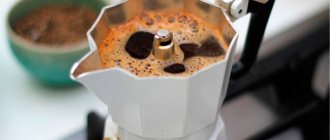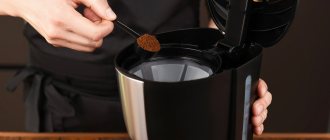- Procedure for brewing delicious espresso at home
- Basic (academic) information about espresso
- Grinding beans
- Coffee dosing
- Grooming and tamping
- Coffee cups
- Water dosing
- Add milk
- Questions and answers
- What are the proportions of coffee and water for espresso? Italian version
- American version
- Espresso vs latte
- Proportions for making espresso
In the article, I described in detail how to make delicious coffee in a manual and semi-automatic espresso coffee machine (“carob coffee maker”).
At the beginning I listed the order of actions, and then the details for each stage. The theory is taken from a professional barista's manual, practice takes into account the peculiarities of home cooking.
Procedure for brewing delicious espresso at home
- Turn on the coffee maker.
- Warm the cups.
- Pour fresh water.
- Spill a little water: without inserting the portafilter, keep it under the stream.
- Drain the portafilter and wipe it dry with a napkin or dry cloth.
- Grind the coffee.
- Pour coffee into the portafilter.
- Perform grooming - evenly distribute the coffee.
- Tamp and remove any remaining coffee from the rim.
- Insert the portafilter into the coffee maker.
- Turn on pre-flow for a couple of seconds. Wait a few seconds.
- Turn on the water supply.
- Monitor the coffee being served. Turn off when the color changes to pale.
- Rate the drink and foam. Consider whether you need to change the grinding or grooming with a tamper.
Method of preparation in a drip coffee maker
To make delicious coffee in a drip coffee maker, you need to insert the filter into the compartment provided for it. Next, pour ground coffee into the filter in an acceptable volume, push the filter in, pour clean water into the reservoir and turn on the device. In a few minutes the drink will be ready.
Brewing coffee in a drip coffee maker is convenient because you can independently determine the strength of the finished drink. To do this, play with the volume of water and the amount of tea leaves. A medium strength drink is obtained by combining 1 tsp. coffee with 120 ml water.
Simple drip coffee maker
When preparing an electrical appliance, make sure that the filter, which is usually made of paper, lies flat in the compartment and is well straightened. If it is damaged, it is replaced with a new one. After preparing coffee, the filter along with the grounds are thrown away, and the reservoir is washed, if necessary.
Many coffee makers are equipped with an automatic heating system for the finished drink. This is convenient when it is prepared in large quantities. If necessary, it is simply heated. There are special recipes for making coffee for the drip device. The fact is that you can put spices and herbs in powder form into the filter along with ground grains. This will make the drink more aromatic and piquant in taste.
Basic (academic) information about espresso
I'll describe a little theory. I left only the most important, be sure to read.
Coffee in a carob coffee maker is obtained by passing hot water under high pressure through a tightly compressed layer of finely ground coffee. As the water passes through the powder, it removes solids and oils from the surface of the coffee particles.
When water passes through a layer of coffee, it follows the path of least resistance. The barista's task is to form a layer with uniform resistance to water flow.
If the coffee layer is poorly formed, a channel appears: an area through which water passes faster. The presence of channels greatly reduces the strength and worsens the bouquet of the drink.
The presence of channels is indicated by a higher coffee yield rate and a yellower color of the extract.
On professional machines with portafilters without a bottom, you can see areas where yellower coffee flows. At home, you have to monitor the trickles.
Filtration phases:
- Pre-wetting. Water is supplied slowly and under low pressure, so the particles in the coffee layer are regrouped and a more uniform resistance to water is created.
- Increased pressure. The pressure increases, the speed of water flow increases, and the coffee layer becomes denser.
- Extraction. The espresso comes from the portafilter basket.
The movement of solids washed out during extraction occurs from top to bottom.
The strength of espresso is determined by the concentration of solids. And when describing the drip method of brewing coffee, they talk about the release of soluble substances.
The coffee grinder is the most important piece of equipment for making coffee. It should provide the required particle size, heat the powder to a minimum, and not produce a lot of husk. No espresso machine can compensate for the problems caused by poor grinding. It is important that the coffee grinder has sharp burrs.
The coffee maker must maintain the required temperature and water pressure.
Which coffee is best for a coffee machine?
When choosing coffee for your coffee machine, you should consider its characteristics. If the unit has a function for grinding beans, then it is best to purchase bean coffee for brewing. If this is not available, you should only buy ground coffee. Capsule machines are a separate category. In this case, tablet capsules are used to prepare the drink, which are manufactured separately for each model.
Among the most popular brands of coffee for coffee machines, it is worth noting Lavazza. It has earned worldwide recognition and has the best selection of varieties in its assortment. The average cost of a small package is 350 rubles. The next equally famous brand is Molinari. The ratio of good quality and low cost pleases a large number of customers. Price - 450 rubles per package. Illy is a coffee brand that has a relatively small range of flavors. But there are different formats for preparation here. Price - from 800 rubles. It is impossible not to mention Paulig. You can find this kind of coffee in almost any supermarket, and the affordable price attracts more and more buyers; on average, it starts at 350 rubles. And the last, no less popular brand of coffee for coffee machines is Pellini. Characterized by the true taste of Italian espresso. It has a strong aroma and a bright aftertaste. Price - from 390 rubles per package.
Grinding beans
To make espresso you need a very fine grind. Thereby:
- the surface area of contact with water increases,
- wetting is accelerated,
- Sufficient resistance is maintained to establish the desired water flow rate.
Make sure there are no lumps in the powder.
It is better to grind coffee immediately before preparation.
This allows you to retain more aromatic oils. And studies have also shown that half of the CO2 was released five minutes after grinding. CO2 is needed for more proper filtration and coffee foam.
What drinks can you prepare?
Using a carob coffee machine, you can prepare coffee that will not differ in any way in taste from a professionally made drink. Baristas note that using a carob coffee maker is best for preparing espresso, latte, cappuccino and glace. This way, you can get different drinks at your own discretion.
- Coarse grinding – a fairly strong taste without bitterness. Almost every person likes it for its richness and simplicity.
- Medium grind – medium strength. Ideal for making cappuccinos and lattes as it combines with milky notes.
- Fine and medium-fine grinding is characterized by strong strength. Therefore it is suitable for morning breakfast.
- The ultra-fine grind produces a taste that tastes like an expensive cafeteria. That is, both men and women will like it.
Cappuccino has a delicate aftertaste and a light creamy aroma. Espresso has a rich bitter taste and aroma.
Coffee dosing
Preparing the Portafilter: Run some hot water into the portafilter before adding coffee. This will rinse the coffee maker and warm the coffee mug.
After this, wipe the portafilter dry with a napkin or clean rag.
We solve the problem - form an evenly distributed layer of coffee. To do this, pour in coffee so that the portafilter is filled evenly. You can fill the coffee in small portions in a circle, resulting in several layers. The second option is to fill in sectors so as to fill the portafilter in one circle.
It is better to pour a little more than required, and remove the excess after grooming. Common dosing standards are described below.
Some useful tips before making coffee
- Before using for the first time, prepare the electric coffee maker:
- carefully read the operating instructions;
- fill the reservoir with water without coffee mass;
- turn on the device;
- After finishing work, drain the liquid.
- Use only high-quality, soft filtered or bottled water. It will improve the taste and protect the device from scale.
- Store ground beans in an airtight container to prevent the coffee aroma from evaporating.
- It is important to remember: the finer the coffee grind, the richer the drink.
- Finely ground beans require less time to brew.
Grooming and tamping
After dosing is completed and before tamping, you need to redistribute the coffee, remove excess and level the surface. This is called grooming.
Using your finger or a straight-edged object (I use a long coffee spoon), push the mound of ground coffee toward the back of the portafalter. Then push it to the bottom, then to the left, then to the right. Finally, pour the excess over the edge.
The surface should be smooth, without pits and without visible irregularities. Read a detailed article about grooming.
Tamping helps to record the results of grooming: to finally smooth the surface of the ground coffee and remove voids in the dry tablet.
For tamping, it is best to use a tamper that fits tightly into your portafilter. The tamper is taken like a flashlight so that the handle lies freely in the palm of your hand, and the thumb and index finger rest on the lower part. Holding the tamper head horizontally, press it gently into the layer of coffee.
Tampering is complete: insert the coffee maker into the coffee maker and wipe the tamper with a dry cloth.
Is it too hard to tamp the coffee? No. It's easy enough to press to get rid of the voids.
With a pressure in the coffee maker of 9 atmospheres and a basket diameter of 58 mm, the pump will press on the tablet with a force approximately equal to the weight of 240 kg. Therefore, your tamping force will not compare to what the coffee will experience in an espresso machine.
Is it helpful to tap the portafilter itself or on it? It is better to do without this, because tapping may cause a gap to appear between the coffee and the wall, which will lead to the appearance of a channel.
Selecting a product for the type of coffee maker
Those who purchase a coffee maker for the first time do not always manage to brew delicious coffee, although they follow all the steps according to the instructions. This can happen if you choose the wrong type of coffee beans. There are 2 types of coffee beans: Arabica (Arabian) and Robusta (Congolese). Pure Arabica is used to make the highest grade of coffee or some types of first and second grade, which are most often a mixture of it with Robusta. It is not used in its pure form, since the grains have no aroma and are used only to create the strength of the drink.
Coffee beans can be sold either whole or ground, while for gourmets the first option is preferable, but the second is cheaper. Ground coffee is usually a mixture of several varieties, which explains its lower cost. If you want to get a tasty and aromatic drink, it is better to purchase whole grains and grind the required amount immediately before use, and store the remaining product in its original form. Grinding can be of the following types:
- Rude. The coffee particles are approximately 0.8 mm in diameter; this coffee is suitable for use in piston or geyser coffee makers. To do this, grind the coffee in an electric coffee grinder for 5-7 seconds.
- Average. Suitable for almost all types of coffee makers. To obtain such a product, you need to use an electric coffee grinder for 10-15 seconds.
- Thin. Used in drip coffee makers. It is necessary to grind the coffee for 15-20 seconds.
- Very thin. Suitable for making espresso in carob-type coffee makers. It is necessary to use the coffee grinder for 20-25 seconds.
- Ultra-thin. The beans are ground almost to the point of dust; this grinding is suitable for making coffee in a cezve (Turk). Use an electric coffee grinder for 25-30 seconds to achieve a super fine grind.
If you are still in doubt about what coffee is suitable for your coffee maker, read the instructions for it. As a rule, manufacturers prefer to include all important information.
Water dosing
Before turning on the water, make sure it has reached the desired temperature - 85–96 °C. Too low a temperature will produce a sour drink, too high a bitter, strong taste. If the temperature indicator on your coffee machine goes out when dispensing water, stop pouring and wait until the light comes on. Some models of home espresso machines have a heat exchanger that is too small for pouring a double portion of coffee.
The optimal water temperature for espresso is approximately 90 °C.
A pre-wet is a brief wetting of the coffee under low pressure. Thanks to pre-wetting, channels are less likely to form and migration of husks is reduced.
Professional coffee machines can be set to pre-wet. You probably just didn’t pay attention to this before. If you're making coffee at home, turn on the brew for a few seconds, then turn it off for a couple of moments, then prepare the espresso.
What should an espresso stream look like?
- The first five seconds are a dark brown stream (or uniform streams from all holes).
- Ten seconds later - a brown or amber stream.
- Further the extract will turn yellow.
The usual time for pouring a shot is 20–30 seconds.
Signs when something is going wrong:
- uneven streams at the beginning,
- rare drops instead of a stream,
- yellow color at the beginning of the strait (both partial and uniform).
Check the grind, water temperature and pressure of your coffee machine.
Add milk
Milk is no less important ingredient in coffee drinks than espresso. When choosing it, it is advisable to try both cold and frothed milk. Cappuccino tastes and feels better before milk separation occurs. Therefore, it is better to drink it freshly prepared.
Hot milk should be added to coffee; the required temperature is 66–71 °C. If you add cold milk, the drink will turn out cool and tasteless.
How to make good foam
Good foam is a dense structure with microbubbles. In a good cappuccino, if you push the milk foam to the side, there should not be a separate layer of milk at the bottom.
A steam wand is used to prepare it. Home coffee machines may require switching modes and time to heat the water.
- pour cool milk into the whipping container (pitcher),
- release a little steam through the pipe,
- lightly dip the tube into the milk in the center of the pitcher,
- open the valve to full pressure, foam and make sure that there are no large bubbles,
- when the milk froths, lower the tube deeper and heat the milk,
- close the valve, remove the pitcher,
- wipe the pipe and let the steam through.
The easiest way is to pour the milk into the coffee using a spoon. The spoon is kept in the pitcher so that the foam remains in it, and the milk flows out first. Then they use a spoon to help move the foam from the pitcher into the cup.
Source
Questions and answers
What are the proportions of coffee and water for espresso?
Italian version
A typical serving is 7 grams per 30 ml shot. 14g - for a double shot of 60 ml.
Regular espresso in Italy is called "normale".
American version
In the States, large volume coffee drinks are popular and they use more coffee. Therefore, American baristas use up to 14 grams of coffee to brew one shot. And the volume continues to increase.
They say that it was in the USA that the triple shot appeared.
Interestingly, due to increasing portions of coffee, it is necessary to increase the temperature of the water, because the coffee in this case absorbs more heat.
Espresso vs latte
Traditional espresso should have a medium strength with an optimal flavor bouquet. Insufficient strength will lead to a decrease in the density of the drink, and too much strength will interfere with the appreciation of the bouquet.
A 350 ml latte should be made from a large dose of coffee and have sufficient strength to ensure a balance between coffee and milk. Strength is more important here because milk mutes the flavors.
If possible, use a single (small) portafilter basket for espresso and a double portafilter basket for café au lait.
In a geyser coffee maker
Making coffee in a geyser-type coffee maker is also very simple.
Coffee machine recipes
Here are detailed cooking instructions:
- pour cold water into the tank to the indicated mark or in an arbitrary volume;
- pour medium-ground coffee into the filter, but do not compact it with a spoon;
- plug in the device or install it on the stove;
- Make sure that the coffee does not boil, otherwise it will become bitter and lose some of its aroma.
The drink will be brewed in 2-3 minutes. After this, remove the device from the heat or unplug it, let the drink brew for 1 minute and pour it into a cup. Typically, a geyser coffee maker is designed for 1-2 servings of coffee. After brewing, the filter and reservoir are washed under running water, dried and reinstalled on the device.
Geyser device
This type of device is loved in Italy, as it is very aromatic and quite strong. How many spoons of coffee to put in the filter is determined by the drink lover himself, but usually the filter is filled completely. Brewing coffee on a stove in a geyser is reminiscent of the process of making Turkish coffee in a Turk or cezve.
How to Brew the Best Coffee: The Secret to Slow Brewing
The trick to brewing the best coffee is to steep the grounds slowly (but not excessively) with water. Applicable only to devices with the ability to regulate water supply power. Therefore, when buying a coffee maker, pay attention to this point.
You can also regulate the brewing speed using the degree of grinding: increase it for slow brewing, and decrease it for fast brewing.
The indicator can be adjusted using the amount of coffee used: to reduce it, pour more.
Terms and rules for storing ground coffee
In this article, we told you how many seconds it takes to grind coffee beans for a carob coffee maker. They also explained the operating principles of this machine. However, it is worth touching on the topic of how to store grains.
The drink that is brewed from freshly ground fruits has the best taste. Therefore, experts advise grinding 10 minutes before cooking. But you can store ground grains for about six months . But during this time they usually lose some of their taste and aroma. Typically choose a dark and dry place to store coffee.
Which coffee machine is better?
There are different types of coffee machines according to the preparation method:
- Automatic – they can independently prepare several types of drinks. They have a milk tank;
- Carob - coffee is placed in a cone. Most often they have a cappuccino maker - a spout that froths milk with hot steam;
- Capsule – the kit includes capsules containing ground coffee;
- Drip – makes a coffee filter.
Based on the ratio of price, quality and speed, capsule coffee makers will come out on top:
- There is no need to put or pour anything anywhere.
- No need to wash the car after use.
- Capsules containing different types of coffee and other drinks with which you can make cappuccino, latte, cocoa and even tea.
DolceGusto capsule coffee machines from krups are popular in Russia. Of course, the consumption of coffee in a coffee machine with capsules is high, but for the sake of quickly preparing the drink, you can turn a blind eye to this.
Many people don’t like drip coffee machines - they make a very weak coffee drink.
What is the best coffee grind for a coffee machine? It is better to use small or medium.
How much coffee per 100 ml of water?
The most basic option and at the same time easy to remember would be the following proportion: 10 grams of coffee – 100 ml of water. However, in fairness, it should be noted that the American Specialty Coffee Association, SCAA generally recommends following a different proportion: 10 grams of coffee - 170 ml of water.
Interesting materials:
What documents are needed to issue an invitation to a foreigner to Ukraine? What documents are needed to issue an invitation to Ukraine? What documents are needed to obtain Russian citizenship? What documents are needed to register as a labor veteran in KhMAO? What documents are needed to obtain a residence permit in Lithuania? What documents are needed to obtain a Ukraine passport 2020? What documents are needed for a holiday in Cyprus? What documents are needed to renounce Armenian citizenship? What documents are needed to open an individual entrepreneur? What documents are needed to open an individual entrepreneur 2022?
